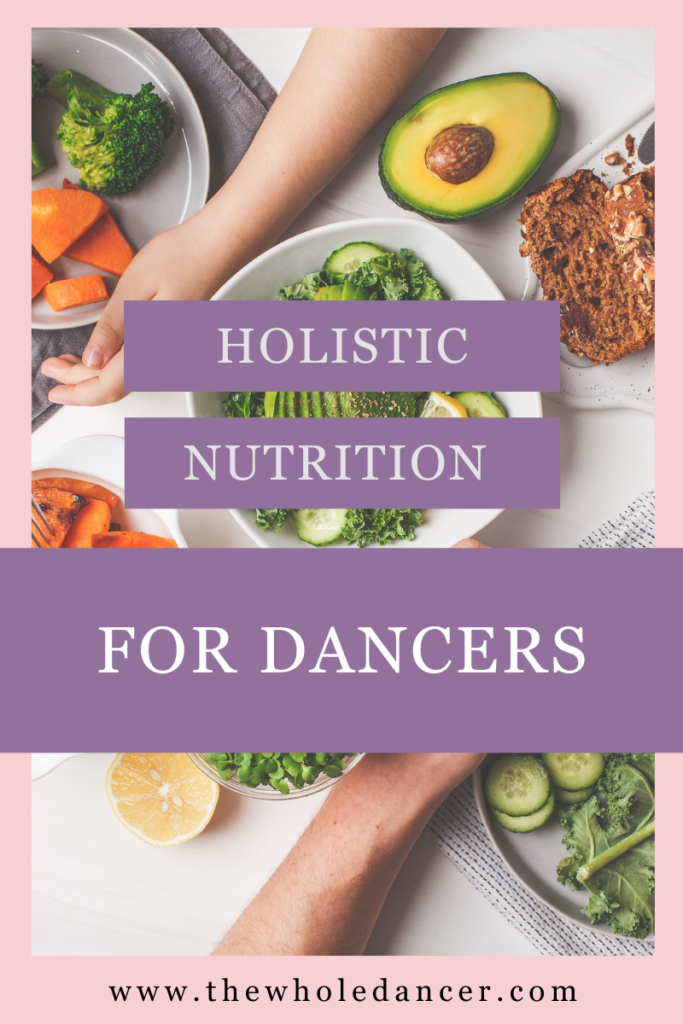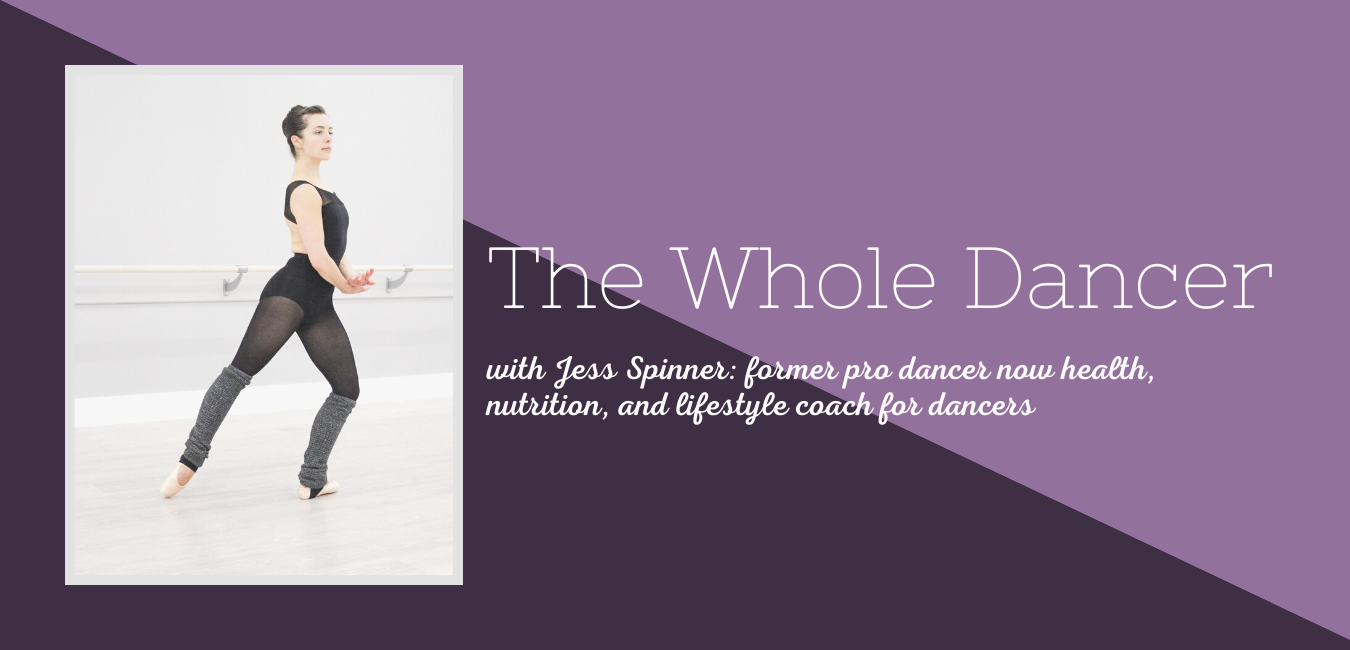What Is “Holistic” All About?
Definition of holistic: characterized by comprehension of the parts of something as intimately interconnected and explicable only by reference to the whole.
The Whole Dancer is about supporting you as a whole person. As a dancer, yes, but you can’t allow your dance pursuits to take precedence over your well-being. For 2022, I’m hoping there can be a greater awareness of holistic nutrition for dancers.
Holistic nutrition for dancers, as shared in this post, is about looking at the big picture. No food is always good for everyone. What might be nourishing, supportive, and enjoyable to you may not work at all for someone else.
Your food values and dancer nutrition.
While it’s incredibly important to work towards the mentality that “all foods can fit” into your dancer eating plan, it’s also a great benefit to consider where your food comes from and what’s important to you in that respect.
Does it matter to you if the meat or other animal products you consume were produced in a certain way (e.g., pastured eggs or “humanely” raised meats)? Does it matter to you if your food traveled a long way thus using human or other resources? Would you prefer that your food be organic or non-GMO, or are conventional production methods OK with you?
The food system in the US is severely flawed. It is the responsibility of all of us to consider our food and grocery choices and the impact of those choices. Do some research, decide on your food values, and move forward adhering to those values to the best of your ability.
Primary Food vs. Secondary Food
This has always been one of my favorite concepts in Integrative Nutrition Health Coaching. Your primary food includes career (this may be dance even if you’re at the pre-professional level), physical activity, spirituality, and relationships. Each of these areas is tied in pretty closely to The Dancers’ Best Body Course because the food you eat really is secondary.
If you’re disconnected from any of your primary food areas, it’s extremely likely you’re struggling to feel calm, balanced, and confident in your food choices. This is where the balanced life wheel comes in.
The balanced life wheel exercise.
Within The Dancers’ Best Body Course, one of the most popular exercises is the balanced life wheel exercise. It looks at even more life areas than your primary food categories and asks you to consider fulfillment in each area (the actual worksheet and journaling includes a visual wheel with each area on a different spoke of the wheel).
- Home environment
- Social life
- Joy
- Health
- Career
- Creativity
- Finances
- Education
- Spirituality
- Home environment
- Relationships
It’s perfectly natural (and OK!) that you’ll go through phases of feeling more fulfilled in some areas than others. Balancing everything in life is a challenge! But the exercise of reflecting, considering each area, and deciding on specific actions to improve fulfillment in the areas that need it is a great benefit to your overall well-being.
Your secondary food: the food you eat…
Now you might be wondering if the food you eat is even a consideration. Yes, it is. However, it’s truly and appropriately secondary. There are some pretty simple things to consider when it comes to your actual food choices.
Create a balanced plate. That looks like including protein, carbohydrates, and fat. It also requires you to consider hydration (drinking half your body weight in ounces of water is the general rule though you may need more if you sweat a lot when dancing).
At each meal, consider including fruits, whole grains, vegetables (those dark leafys are all-stars), protein, and fat. Your fat sources can be whole food sources like nuts, seeds, or avocado. Other fat sources might be oils, sauces, or dressings.
Balancing hormones with food
It’s essential to acknowledge that food has a big impact on the secretion and production of a number of hormones. Your hormone levels have an effect on your energy, stress levels, sleep, weight, and levels of hunger or fullness (and more!). They play a huge role in your everyday, normal functioning.
For so many, stress hormone (cortisol) levels wreak havoc on feelings of balance and well-being. Elevated cortisol can be a symptom of insufficient sleep, excessive exercise, inability to cope with stress, challenging relationships, and an eating plan lacking in nourishment. “What’s more, one study found a diet high in added sugar, refined grains, and saturated fat led to significantly higher cortisol levels compared with a diet high in whole grains, fruits, vegetables, and polyunsaturated fats.¹”
Relationship to food
Holistic nutrition for dancers isn’t just about the food you eat. It’s about how you’re relating to that food. If you’re stressing, obsessing, and overthinking every bite, it’s time to address your relationship to food. If you’re feeling guilty or regretful after eating something, then it’s time to address your relationship to food.
So much of your food relationship is based on habit, family experiences, and messages you’ve gotten from the media, dance teachers, and friends over the years. It takes a lot of intentional thought and reflection to shift the way you view and relate to food. However, it’s 100% possible, and for dancers especially, it’s essential.
The dancers I work with and the goal I hope to support all dancers in achieving is confidence in your food choices. When you are able to stop questioning each bite and move through a day, week, month, and year making food choices with ease, you’ll gain an assured feeling that can truly calm your mind. Food should not be stressful!! It should be fueling, fun, carefree, joyful, and nourishing.
Connection to your body
The thought and reflection that’s needed in your food relationship is needed for many dancers in the body department as well. It sometimes still surprises me (though I also totally get it because I’ve been there) that you can expect so much from your body in dance and yet remain so disconnected from it.
Dancers are masters at ignoring body signals and cues. It makes sense. You’re taught to ignore the pain. To push through the challenges. Many dancers are still given the very harmful message to ignore your hunger.
To reconnect to your body, try yoga (no mirrors allowed), meditation, mindful eating, honoring your pain (emotional and physical), or intentional breathing. These are just a handful of ideas to get you started.
If you’re ready for the deep dive into a more holistic approach to nutrition for dancers, sign up for the free Holistic Nutrition for Dancers virtual workshop and consider The Dancers’ Best Body Course + Group Coaching Program. Now Enrolling.
Resources and scholarly articles are linked throughout this post. Additional resources:
https://www.healthline.com/nutrition/ways-to-lower-cortisol#TOC_TITLE_HDR_12


The Food We intake should be nutritious and not just bare calories and I found this blog very informative being a dancer we need to be precise about what we eat
Hi Laura! Thanks for reading and for sharing your thoughts! Prioritizing nutrient dense foods can be a benefit to dancers. I wouldn’t say dancers need to be “precise” but staying mindful and intentional is key. Thank you again for reading!
Best,
Jess
Pingback:Your Best Body for Dance in 7-Steps - The Whole Dancer
Pingback:What Is Good Nutrition for Dancers? - The Whole Dancer
Pingback:Refreshing Your Food Mindset before the New Year - The Whole Dancer
Pingback:The Whole Dancer Plate - The Whole Dancer